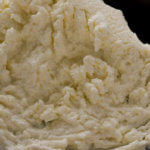
This month, Chef Bret Bannon educates us on how to make homemade ricotta cheese using Kalona SuperNatural™ non-homogenized milk. You will need two half gallons of our organic whole milk and a pint of our wonderful cream to make this ricotta. Since you will be carefully heating milk to just about 185 degrees–you will also need your instant-read thermometer.
It’s easier than you might think, but it does take a little bit of time. Most of it can be completed while you are grocery shopping, enjoying lunch with a friend or looking through a new cookbook. Your results will be delicious and far better than anything you will find in a supermarket.
After making the cheese, you can use it in a variety of dishes like a Ricotta and Strawberry Tart. There will be enough remaining to make ricotta gnudi (pronounced “nu-dee”) to serve with homemade bolognese sauce. Gnudi is a type of gnocchi made with whole milk ricotta cheese and a little bit of all-purpose flour.
Chef Bannon served these little pillows of heaven with a Bolognese sauce. Generally, a sauce like this is very dense and hearty. If serving with the gnudi, you may lighten it by adding some homemade chicken stock.
Print
Homemade Ricotta Cheese by Chef Bret Bannon
- Yield: Makes about 2 3/4 pounds Ricotta Cheese 1x
Ingredients
- 128 ounces (two half gallons, 64 oz. each) Kalona SuperNatural™ organic whole milk
- 16 ounces Kalona SuperNatural™ Whipping Cream
- 1/4 teaspoon salt (more if you want a saltier taste and if you are not going to use it for desserts)
- 1/3 cup plus 2 1/2 tablespoons distilled white vinegar, divided
Instructions
Rinse the inside of a large non-reactive pot with cold water (this helps prevent the milk from scorching). Add the milk and cream to the pot and place on medium heat. Add salt and stir briefly.
Allow milk to heat up slowly, stirring occasionally. After a few minutes, you will notice steam starting to form above the surface and tiny bubbles appearing on the milk. You want it to reach 180-185°F, which is near scalding temperature, just before it comes to a boil. Check the temperature with your instant read thermometer. When it reaches the correct temperature, take the pot off the burner.
Add the vinegar and stir gently for only one minute. You will notice curds forming immediately.
Cover with a dry clean dishtowel and allow the mixture to sit undisturbed for a couple of hours. (This is when you get to go do your shopping or grab a coffee with a friend!)
When the ricotta has rested for about 2 hours, take a piece of cheesecloth, dampen it and place it inside a colander. With a slotted spoon, ladle out the curds into the prepared colander. Place the colander with ricotta curds inside a larger pan so it can drain freely.
If there is still a great deal of milk in the pot, return it to the fire and heat again to 185°F. Take it off the heat. Stir in an additional 2 tablespoons of vinegar and allow to sit again for another two hours.
Ladle out the additional curds into the other that is draining. Let it drain for about two hours or even overnight, depending on how creamy or dry you want your cheese to be.
When it has drained to the desired consistency, remove it from the cheesecloth and store it in a tight sealed container.
Refrigerate until ready to use. It will keep for up to 7 days. Unfortunately, ricotta does not freeze well.
Other serving suggestions: Ricotta can be served as an appetizer on crostini or cracker, or used in a sauce in place of cream.
Notes
Recipe used by permission of Bret’s Table.
